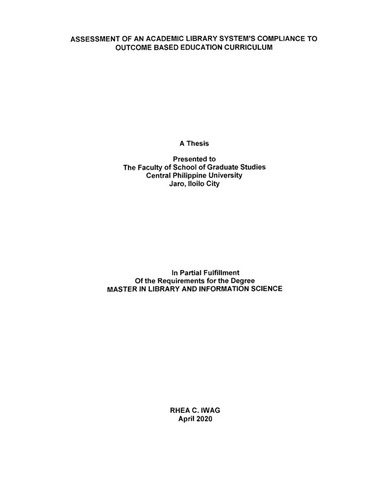| dc.description.abstract | This study was conducted to determine the extent to which the use of the library may have affected academic performance among college students of JBLFMU - Molo campus SY 2009 - 2010. The study furthermore determined the significant differences in the respondents’ extent of use of the library and their academic performance when classified according to their age, sex, course and year level and the significant relationship between extent of use of the library and academic performance of the students. The descriptive-relational research made use of a researcher-made and validated questionnaire. The data on the level of academic performance were based on the general weighted average grades of the students in their academic subjects obtained from the school registrar. Included in the study were 363 respondents from the six (6) courses offered by the University. The data gathered were tallied and analyzed using the frequency, percentage count, mean, Z-test and one-way analysis of variance (ANOVA) and Pearson Product-Moment Coefficient. All the inferential statistics were set at .05 alpha level.
Major Findings
The results of the study show that the majority of the respondents were 16-18 years old, male, enrolled in BSMAR-E, and first year level.
The respondents generally seldom utilized the library resources, meaning they used them once a week. More than one-third (36.1 percent) of the respondents sometimes utilized books, and from one-third and lesser seldom utilized the other printed resources. The vertical files / clippings were the least utilized resources. With regards to library services, the most utilized by the respondents were those in library registration while the least utilized were those of reference interview / library queries; loans of library services and book reservation. As to facilities, the most utilized by the respondents were those in computer units / laptop / multimedia while the least utilized were those in karaoke.
Extent of utilization by the respondents of library resources, services and facilities does not significantly vary according to their age and sex. There were significant variations in their course and in their extent of utilization of library resources, services and facilities. The students’ extent of utilization in the areas of library services and facilities also significantly vary according to year level but not on library resources.
Respondents’ academic performance significantly varies according to their age, sex and course. However, academic performance is not significant according to year level.
No significant correlation was found between the extent of utilization and academic performance of the respondents.
Conclusions
Based on the findings of this study the following conclusions were drawn.
1. Most of the library resources were seldom utilized by the respondents. More specifically, books, magazines, newspaper, dictionaries and encyclopedia were generally sometimes utilized by over one-fourth of the respondents but vertical files / clippings, almanacs, Filipiniana were never utilized by about three-fourths or less of the respondents.
2. Most of the library services were seldom utilized by the respondents, which included internet access, encoding, printing; library service hours and availability of the librarian, staff and student aides to cater to library needs gamering a range of between (30-50 percent) of responses. The services that were never utilized by over 50 percent of the respondents were reference interview / library queries, book reservation, library material loans and interlibrary services.
3. Most of the library facilities were also seldom utilized by the respondents. The computer units / laptop/ multimedia, chairs and study carrels were sometimes utilized by one-fourth to one-third of the respondents, and the facilities never utilized by over three-fourths of the respondents were karaoke, microphone and periodical index catalog (manual).
4. The age of the respondents had no significant bearing on the extent of utilization in resources, services and facilities. 5. The sex of the respondents had no significant bearing on the extent of utilization in library resources, services and facilities.
6. Utilization of library resources, services and facilities significantly differed according to the respondents’ courses.
7. Year level of the respondents however significantly contributed to the variation in the extent of utilization of library services and facilities but not in library resources.
8. Age had slightly affected the academic performance of the respondents.
9. The sex of the respondents had a slight significant bearing on the academic performance.
10. Course of the respondents however significantly contributed to the variation in the academic performance.
11. The respondents’ academic performances were not affected by the year levels.
12. Extent of utilization in library resources, services and facilities were not correlated to the academic performance of the respondents.
Recommendations
In view of the findings and conclusions drawn from the study, the following recommendations for the improvement and development of JBLFMU - Molo College Library are made:
1. The general trend of less utilization should seriously be addressed on nearly all categories of resources, services and facilities. While it may be noted that library orientation was missed by majority of freshmen marine engineering students at the period of this research, it should be required of all freshmen and transferees. Likewise, a strong library marketing policy should be devised and implemented. This policy could include book fairs, exhibits, library use contests and others sponsored by the library. The library staff should take the initiative of undertaking library promotional activities, and the school administration should follow-up with vigorous logistics and cooperative support. 2. Whereas no correlation between library utilization and academic performance exists it is noted that generally academic performance still maintained good level of grades, and that excellence is not very far if the library were made a strong enhancing factor with administrative and faculty support.
3. Further research may be needed in the near future to prove some positive correlation if the above were improved. | en_US |





